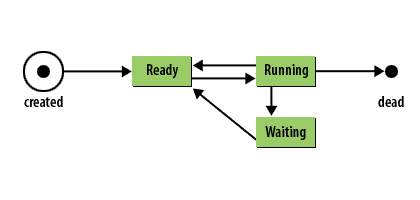| Lesson 4 | Thread States |
| Objective | Describe the different processing states that apply to executing threads |
Java Thread States
Once a thread has been started, it may not execute immediately, and when it does, it rarely executes all the way through to completion.
This is because the thread must share the system's CPU or CPUs with other threads.
A thread can be only in one of five states
- New: This is the state the thread is in after the Thread instance has been created but the
start()method has not been invoked on the thread. It is a live Thread object, but not yet a thread of execution. At this point, the thread is considered not alive. - Runnable: This is the state a thread is in when it is eligible to run but the scheduler has not selected it to be the running thread.
A thread first enters the runnable state when the
start()method is invoked, but a thread can also return to the runnable state after either running or coming back from a blocked, waiting, or sleeping state. When the thread is in the runnable state, it is considered alive. - Running: This is where the action is. This is the state a thread is in when the thread scheduler selects it from the runnable pool to be the currently executing process.
A thread can transition out of a running state for several reasons, including because "the thread scheduler felt like it." We will look at those other reasons shortly.
There is only one way to get to the running state: The scheduler chooses a thread from the runnable pool. - Waiting/blocked/sleeping: This is the state a thread is in when it is not eligible to run.
This is really three states combined into one, but they all have one thing in common:
The thread is still alive, but is currently not eligible to run. In other words, it is not runnable, but it might return to a runnable state later if a particular event occurs. A thread may be blocked waiting for a resource (like I/O or an object's lock), in which case the event that sends it back to runnable is the availability of the resource.
For example, if data comes in through the input stream the thread code is reading from, or if the object's lock suddenly becomes available. A thread may be sleeping because the thread's run code tells it to sleep for some period of time, in which case, the event that sends it back to runnable causes it to wake up because its sleep time has expired - Dead: A thread is considered dead when its
run()method completes. It may still be a viable Thread object, but it is no longer a separate thread of execution. Once a thread is dead, it can never be brought back to life.
If you invokestart()on a dead Thread instance, you will get a runtime (not compiler) exception. If a thread is dead, it is no longer considered alive.
Thread State Changes
| From | To | Circumstance |
| New | Runnable (ready) | The thread is started as a separate execution sequence. |
| Runnable Oracle Docs : Runnable | Running | The thread is scheduled by the task scheduler. |
| Running | Runnable (ready) |
|
| Running | Dead | The thread's run() method completes its processing. |
| Running | Waiting |
|
| Waiting | Runnable (ready) |
|
In addition to the names listed above, there are other names for
thread states.
Learning how a thread transitions from one state to another is key to mastering multithreading. The following MouseOver tooltip and the remainder of this module describe these state transitions.
Learning how a thread transitions from one state to another is key to mastering multithreading. The following MouseOver tooltip and the remainder of this module describe these state transitions.

- A thread object's start method is invoked causing the thread's run() method to be invoked by the JVM.
- The task scheduler schedules the thread based on the thread's priority and its scheduling algorithm.
- A thread invokes its yield() method; or the task scheduler schedules another thread.
- A thread invokes its sleep() method; or a thread blocks on I/O; or a thread's suspend() method is invoked; or a thread waits for a lock; or a thread invokes an object's wait() method.
- A thread has finished sleeping; or an I/O operation is completed; or a thread's resume() method is invoked; or a thread acquires a lock; or a thread is notified that an object is available; or a thread's interrupt() method is invoked.
- A thread's run() method returns; or a thread's stop() method is invoked.
Five Thread States